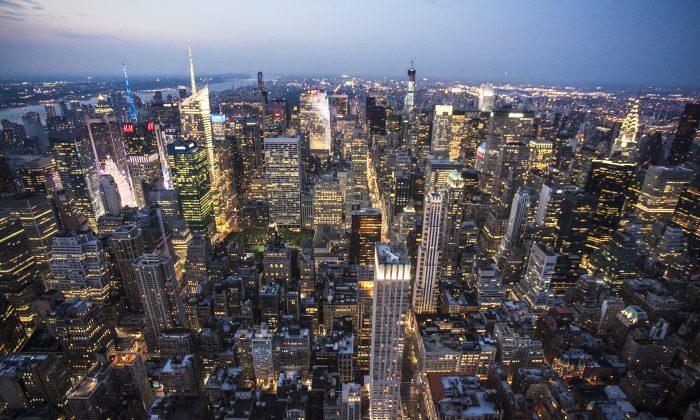New York is a city full of skyscrapers, landmarks, over 300 neighborhoods, varied landscapes, experimental architecture, and iconic buildings. Each has its own set of supporters, and sometimes they are placed in direct opposition.
Despite the varied and seemingly constant change in the built environment, New York has very vocal NIMBYs, said Fordham University graduate Nikolai Fedak.
NIMBY (Not In My Back Yard) was a term popularized in the 1980s, and generally refers to a group of residents who do not oppose a project necessarily, but do not want the project anywhere near their neighborhood.
To counteract that narrative, in 2011 Fedak started the popular development blog New York YIMBY (or Yes In My Backyard) to give voice to those who are pro-development (who are many, he found) and weigh in on projects across the city.
The blog is constantly updated with new building permit filings, renderings, project updates and such, with comments on designs and architecture.
Epoch Times interviewed Fedak on the growth of YIMBY, and whether New York is really a NIMBY-run town.
Epoch Times: How did you get the idea to start YIMBY?
Nikolai Fedak: I started YIMBY in my free time as a way to track new development in New York City. I’ve always been interested in urban issues, and buildings in particular, and this was a good way of putting my time walking around the city to good use. Since then, it has grown into much more, but it definitely started from my love of the city and its buildings.
Epoch Times: Do you think NIMBY-ism is prevalent in New York? Where do you think that comes from?
Mr. Fedak: NIMBYism is highly prevalent in New York and ironically it is the process of gentrification that is often the cause. Wealthy new residents often have the time and money to oppose new development, generally on the basis of selfish or petty interests like the blocking of views. As prices increase, this exacerbates supply shortages further, and NIMBYism is largely to blame for the increasing homogeneity of neighborhoods like Williamsburg.
Epoch Times: How did you get interested in development, and what aspects are you most interested in?
Mr. Fedak: Growing up I always played SimCity and the Sims, and architecture is definitely one of my favorite interests. Development just comes along with the territory, but I think New York City is in a very interesting time, in terms of its history. We now have super tall (1,000 foot +) towers rising all over Manhattan, and most of this is being dictated by pure market forces rather than government spending (like in the Middle East). The transformation of the skyline over the next decade will be dramatic to say the least, and that is going to be fascinating to watch.
Epoch Times: What are some projects and reactions you’ve found most shocking?
Mr. Fedak: I think the reactions to large developments in the outer boroughs are especially concerning, as well as the East River Plaza redevelopment in Harlem. Along with the Domino Redevelopment and Astoria Cove, affordable housing advocates have made a big fuss about nominal increases in units to be set aside for affordable housing. Unfortunately these demands decrease the feasibility of new development, and it’s not like they put any reasonable dent in the worsening housing crisis, where hundreds of thousands—if not millions—are in need of housing within their budget.
I don’t understand how people can’t see that supply is the issue, not demand, and if we do not build to meet supply then prices will continue to increase; it is economics 101. And demand is clearly not decreasing! The best way to reduce the cost of housing is to build more of it, whether it is market rate or affordable, we just need lots more of it.
People often use the argument for a greater percent of affordable units as a strawman, and instead oppose development regardless of the affordable component.
Epoch Times: How has YIMBY grown, and in what direction do you see the site going?
Mr. Fedak: YIMBY now sees over 100,000 unique visitors and 1 million pageviews per month. We have another editor, Stephen Smith, and other writers as well. It is great to see the site receive such a positive response from the public, and I think it’s an affirmation that New Yorkers want to see positive change in their city, it’s just that the negative voices are often the loudest.
Epoch Times: Do you think anything can be done about ugly buildings?
Mr. Fedak: Unfortunately not, but what is ugly is often subjective. We find that people tend to become accepting of buildings of their grandparents’ age and older, and while some of the monstrosities from the ‘60s and ’70s could very well fail that test, it does seem brutalist architecture and other midcentury styles are gaining more appreciation as they age.
Of course, the problem in New York City is that minimal subjective taste is often adequate for land marking, which is also a factor behind NIMBYism and hindering development. I think one must always consider the intention of the original developer and architect when building a structure. And if it was not conceived with a purpose to stand for time eternal, why preserve it?
So basically ugly buildings tend to age out of the urban fabric after decades or centuries. It just takes someone with (hopefully) better taste to knock them down.






Friends Read Free